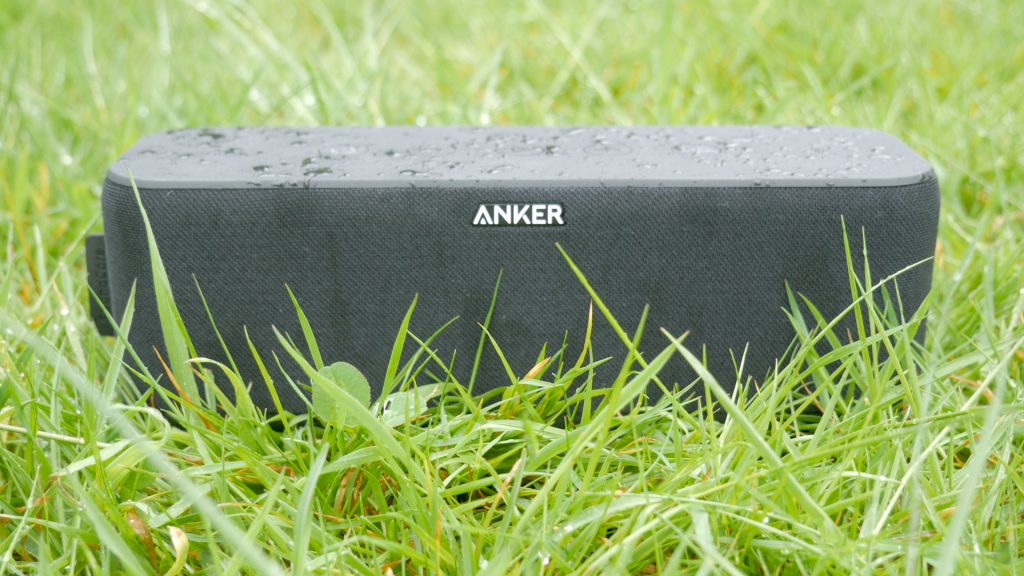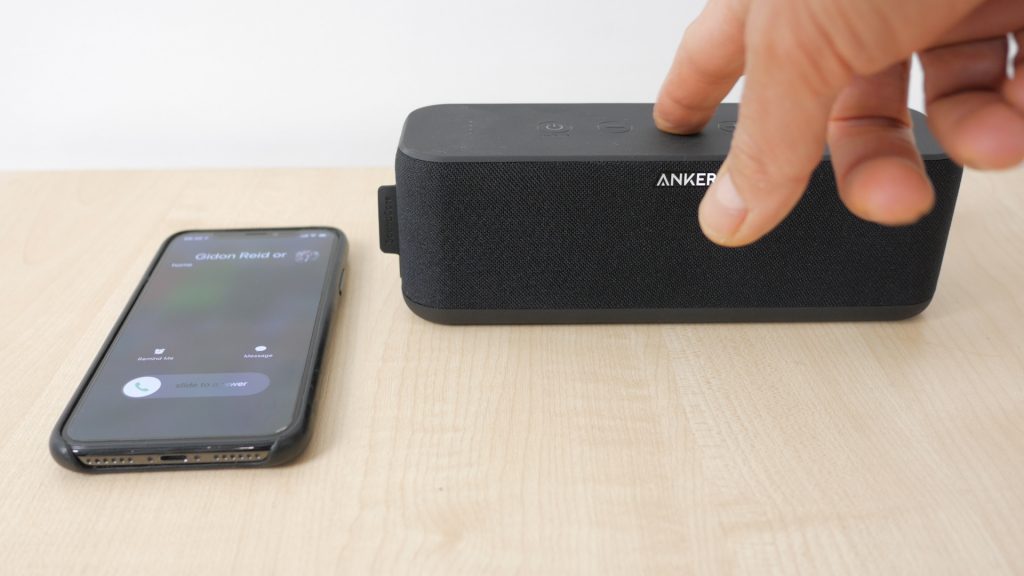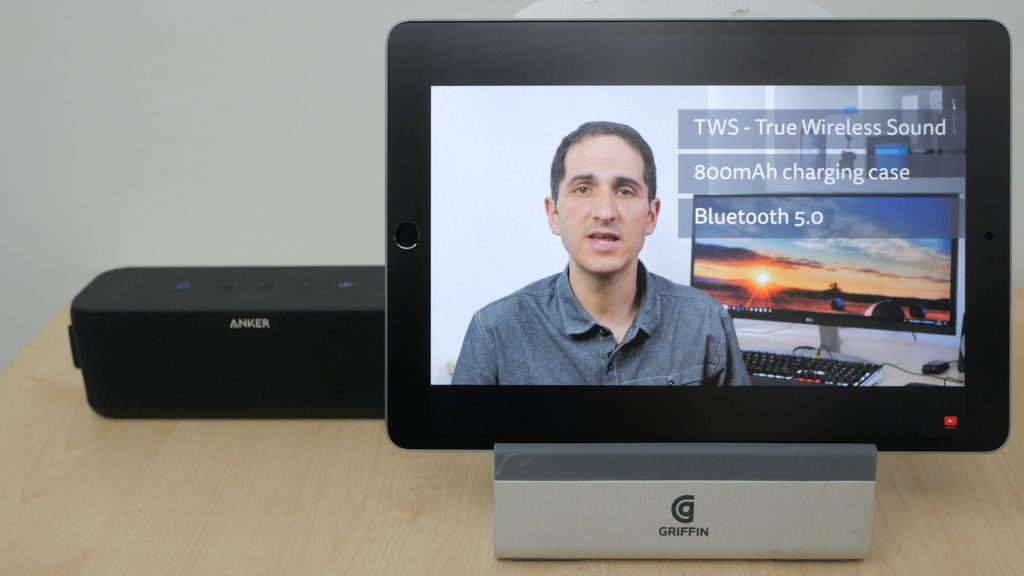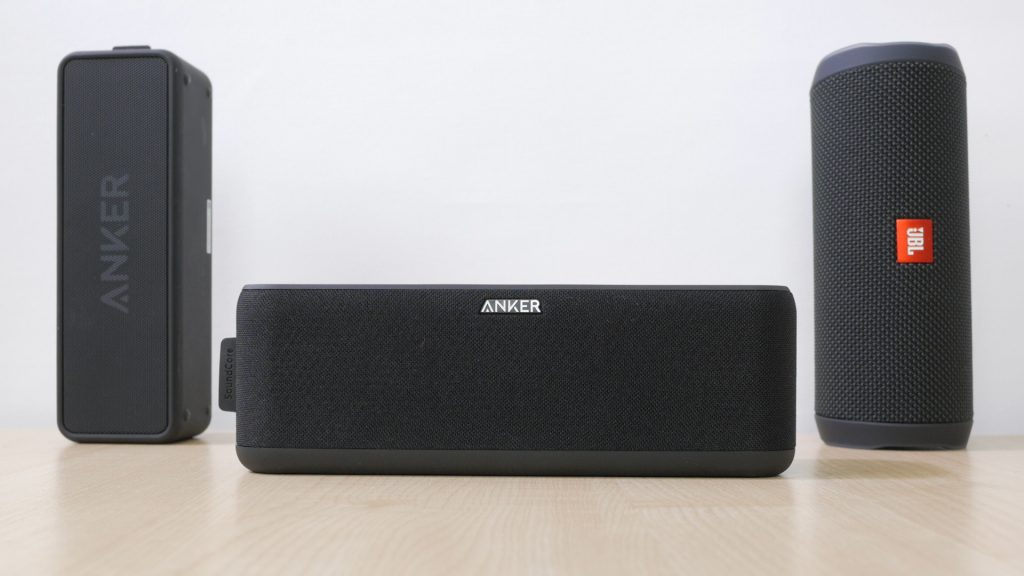The Soundcore Boost is a portable Bluetooth speaker from Anker, costing around £50 or $60. It sits towards the higher end of Anker’s current range of portable speakers. It has up to 12 hours of battery life, an IPX5 water resistance rating, a USB charging port and features Anker’s BassUP technology which is meant to enhance bass at lower volumes.
I’ll be comparing it against the cheaper SoundCore 2 I reviewed a while back and the popular JBL Flip 4 that is almost twice the price, but similarly spec’d.
First impressions

Inside the box you get a basic instruction manual, the speaker itself and a non-branded slightly cheap feeling micro-USB cable. There’s no wall charger or 3.5mm auxiliary cable for a wired connection to the speaker.
First impressions of the speaker are good. It feels very sturdy with no flexing however hard you try, and has a matte plastic top and bottom with small rubber feet. The front and back of the speaker are wrapped around with a fine fabric, making way on one side for a tight fitting cover over the ports. It’s quite boxy with only slightly rounded edges, and has physical buttons that sit flush along its top. The Anker branding on the front of the speaker is far more subtle than on its SoundCore 2 sibling.
It weighs 585g and measures 193mm x 62mm x 65mm – a little heavier and bigger than the SoundCore 2 and Flip 4, but still very portable, just perhaps not as travel friendly.

It looks well sealed and I’d be more than confident in its IPX5 water resistance rating. It shouldn’t be submerged in water, unlike the Flip 4, but it will survive a splash or a rain shower. And it has a hydrophobic coating so water doesn’t soak the speaker fabric.
Getting started and overview

There’s a small tab on its side, embossed with SoundCore branding. Pulling this firmly reveals a micro-USB charging port, an aux-in port for a wired connection and a standard USB charging port for charging your gadgets off the 5200mAh internal battery. Something neither the SoundCore 2 or the Flip 4 have.
I would have liked to see a more robust USB-C charging port, but it does support charging at 2.1A, which along with the right charger charges the battery from empty in under four hours. When you plug it in, the charging status LEDs light up according to its remaining charge. When all four LEDs are steady white, it’s reached full capacity. You can use the speaker whilst it’s charging.

The USB-A charging port only has 1A output as is so ofte n the case on these sort of devices. I would really like to see a 2A output – 1A is enough for most phones but not sufficient for tablets or other devices with larger batteries. It has Anker’s IQ charging technology which is meant to identify the connected device to deliver the fastest charge possible. It delivered just under 1A to an iPhone X and iPad Pro and 1.15A to a Samsung tablet.
A single press of the power button turns the unit on and off with audio feedback that can’t be disabled. The first time you turn it on, the power LED flashes blue to indicate pairing mode. Choose “SoundCore Boost” from your device’s Bluetooth settings. There’s a confirmation beep and the blue power LED will go steady. On Apple phones and tablets you can see the battery status, by swiping right from the home screen.
Whenever you turn the unit on again it will connect to this last connected device. If that’s not available the power LED will flash blue again ready for pairing.
You can’t configure two speakers in a stereo pair like with the Flip 4, and more importantly it doesn’t support pairing to multiple devices, so you’ll need to disconnect from your phone, say, to connect to your tablet. You can unpair any connected device, by holding the power button down for more than four seconds when the unit is on. You’ll hear the speaker’s confirmation beep that it’s back in pairing mode. I would prefer a dedicated Bluetooth button like on both the cheaper SoundCore 2 and the Flip 4.

The whole Bluetooth pairing is clumsy compared to the Flip 4 say, which can be connected to two devices at the same time, and will automatically play from the device you’re currently using. But it’s only really an issue if you do need to change the connected device often, and you do get used to it.
You can reset the speaker and remove all Bluetooth pairing records by holding the power button down for more than four seconds with the power off.
The speaker also has NFC support so you can pair quickly with a supported device just by tapping it on the NFC sensor to the right of the buttons. Unfortunately I don’t have any devices that support this.
When you turn on the device or press any buttons, the white charging LEDs light up according to the unit’s charge for up to 10 seconds and then turn off.
Apart from the combined power & Bluetooth pairing button, there’s a volume down, play | pause, volume up and the BassUP button which I’ll discuss shortly, but by default is on and lit white. All the lights are quite faint – so you have to look quite closely to see if they are on, in bright light at least. There’s no app to configure the speaker.
The play button can also skip forward a track with a double press, but there’s no way to skip back a track. A long press of the play button will activate your voice assistant. So I could say, what’s the weather in London?

The speaker’s microphone, also allows it to handle phone calls should you wish. The play button will answer or end a call.
The volume controls sync with my iOS devices, but not my Android tablet. So the maximum volume on my iPhone or iPad is the maximum volume on the speaker. There’s a confirmation beep that interrupts the music when you reach full volume. If you’re connected via a 3.5mm cable, there’s no volume synchronisation.
It is possible to update the firmware on these units which I did, but it’s not exactly clear what was fixed or added. Perhaps audio latency issues but I didn’t test this before doing the update.

If you want to update your firmware, I’ll add links in the description. Let me know if you are able to confirm anything it adds or fixes! You install and run the Anker Software Upgrade Utility and then with your unit off, connect it to a computer whilst holding down the volume down and up buttons, until the Anker software recognizes the connection. Then select the new firmware file to finish the upgrade. I couldn’t get this to work with the supplied micro-USB cable, but it worked fine with another cable I had.
Performance and sound quality

Battery life is rated at 12 hours at 60% volume and with BassUP off. I got close to this and about half that at full volume with BassUP on. It’s similar to the quoted battery life for the Flip 4 but less than the SoundCore 2 which has almost double the battery life.
The SoundCore Boost has Bluetooth 4.2, not the more recent 5.0 standard, but range was good reaching the next room of the house around 10 metres away and was comparable with the SoundCore 2 and only very slightly less than the Flip 4.
The speaker has two full range 10W drivers, versus the 6W drivers in the SoundCore 2, which would account for the reduced battery life to some extent. There are passive radiators for the lower frequencies. This is not a 360 degree speaker so you will have to pay some attention to placement.
As a speaker phone it works quite well, although the microphone didn’t sound so good to the call’ee unless I got very close to the speaker.

Audio delay watching YouTube and Netflix was barely noticeable and even slightly better than the Flip 4.
Sound quality is very good and it’s loud enough to fill a medium sized room or to be used outside. I measured it around 2dB louder than the SoundCore 2 and about the same as the Flip 4 at 1 metre away. There’s a good amount of bass for a speaker this size and compared to the competition, and the BassUP button does have an noticeable effect but only at lower volumes. At above 60-70% I really couldn’t hear any difference. It gives the speaker a fuller sound that sounds impressive for the speaker’s size.
The mids also sound good and it’s only when you compare it directly to the JBL Flip 4 that you notice vocals and treble sound a little muddy with not as much clarity as the Flip 4, which does sound very bright – if sometimes a bit harsh. There’s little distortion as you increase the volume, but the muddyness does become more exaggerated.

You can listen to a comparison between the SoundCore Boost, with BassUP on and off, the JBL Flip 4 and the SoundCore 2, by watching the video at the top of the page. I’d recommend using headphones to really hear any differences.
Conclusions
The Anker SoundCore Boost is a capable speaker that I think most people would be very happy with. It sounds good, it’s well built, it’s loud, it has some water resistance and it will even charge your phone. At £50 or $60 I think it offers good value for money.
The improved sound quality and USB charging make it worth the extra money over the SoundCore 2, if you don’t need the extra battery life, or smaller, lighter form factor. I do slightly prefer the clarity of the Flip 4 even if it can sound a bit harsh, especially for spoken audio like podcasts. But the Flip 4 does cost more than the Boost, and a lot of people will prefer the extra bass of the SoundCore Boost.
Ideally I’d like to be able to pair with at least two devices at the same time, and the speaker can’t be submerged in water – both features the Flip 4 has. But I’d have no trouble recommending this speaker, especially if you can get it in one of Amazon’s frequent sales – check the links in this video’s description for the latest prices.
Don’t forget to take a look at my YouTube video at the top of the page, and subscribe to my YouTube channel where I’m releasing videos every week on the latest technology and how to get the most out of it. If you tap the bell icon when you’re subscribe you’ll get a notification as soon as I release a video, and there’ll be a link to my site here for the written article. YouTube is also the best place to leave a comment. I read all of them and respond to as many as I can!
Anker SoundCore Boost: https://amzn.to/2KzhTo9
Anker SoundCore 2: https://amzn.to/2WmzNgr
JBL Flip 4: https://amzn.to/2WQyXwr
Hi, there are so many scientific issues in the printer setup. So, If you have any kind of issues about setup dell printer. Our experts will help you solve all the technical issues and you can also visit our website.
Behold is an important prize for winning. thetechnologyman.com
http://bit.ly/2KwgyPb
I was just wondering if the boost is capable of Wireless Stereo Pairing? Apparently on the updated soundcore 2 this is possible